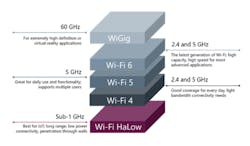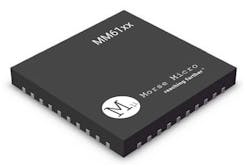This article appeared in Electronic Design and has been published here with permission.
Check out more of our CES 2023 coverage.
What you’ll learn:
- What is HaLow?
- How this partnership will help nudge IoT forward.
- General specs of the HaLow chip.
At CES 2023, Morse Micro announced a partnership with AzureWave Technologies to design and develop two Wi-Fi HaLow modules, including the smallest type, a 13- × 13-mm module. Both FCC-certified module designs feature Morse Micro’s MM6108 microchip, a fast, low-power Wi-Fi HaLow system-on-chip (SoC) that offers 10X more range than traditional Wi-Fi solutions (Fig. 1).
“Wi-Fi HaLow continues to gain momentum in the IoT ecosystem, and our collaboration with AzureWave builds on this energy as we scale and accelerate the deployment of Wi-Fi HaLow solutions worldwide,” says Morse Micro co-founder and chief executive officer Michael De Nil. “By joining forces, Morse Micro and AzureWave are poised to design and deliver best-in-class Wi-Fi HaLow solutions that will enrich existing communication modules in a broad range of IoT and consumer electronics applications.”
Since Wi-Fi HaLow is geared toward IoT devices and taps into the lower-frequency ranges, it requires Wi-Fi HaLow-enabled access points or hubs for compatibility (Fig. 2). The company is working with leading worldwide ISPs to incorporate Wi-Fi HaLow into next-gen home gateways and developing solutions that allow existing customers to introduce Wi-Fi HaLow as soon as possible.
It also comes with scalability, robustness, and security essential for the toughest connected environments. Overall, one Wi-Fi HaLow-enabled access point supports over 8,000 IoT devices, which means it provides connectivity for large ecosystems in the industrial, agriculture, smart-building, and smart-city sectors. Wi-Fi HaLow extends to areas that are deemed unreachable by 2.4-GHz wireless technology and at much faster speeds than other sub-gigahertz IoT protocols.
“As a leading wireless module maker, AzureWave provides design and manufacturing services that ultimately shorten the customer’s development process and time-to-market, enabling the end-products to be more compact, value-added, and extremely low power,” said Gary Cheng, president and chief executive officer at AzureWave Technologies Inc. “Our partnership with Morse Micro demonstrates the continued global demand for Wi-Fi HaLow solutions, and it provides the opportunity to rapidly scale Wi-Fi HaLow for countless IoT devices.”
Morse Micro also is working with Matter to develop secure IoT ecosystems through the Connectivity Standards Alliance (CSA) to make Wi-Fi HaLow compatible with that communications protocol. However, the company is focusing less on Zigbee and Thread due to their low-speed, short-range IoT applications.
Anyone can purchase the 13- × 13-mm and 14- × 18.5-mm modules through AzureWave. In addition, Morse Micro is working on evaluation platforms to integrate these modules for customers. Later this year, Wi-Fi HaLow is expected to be available for the maker and hobbyist communities.
Check out more of our CES 2023 coverage.


